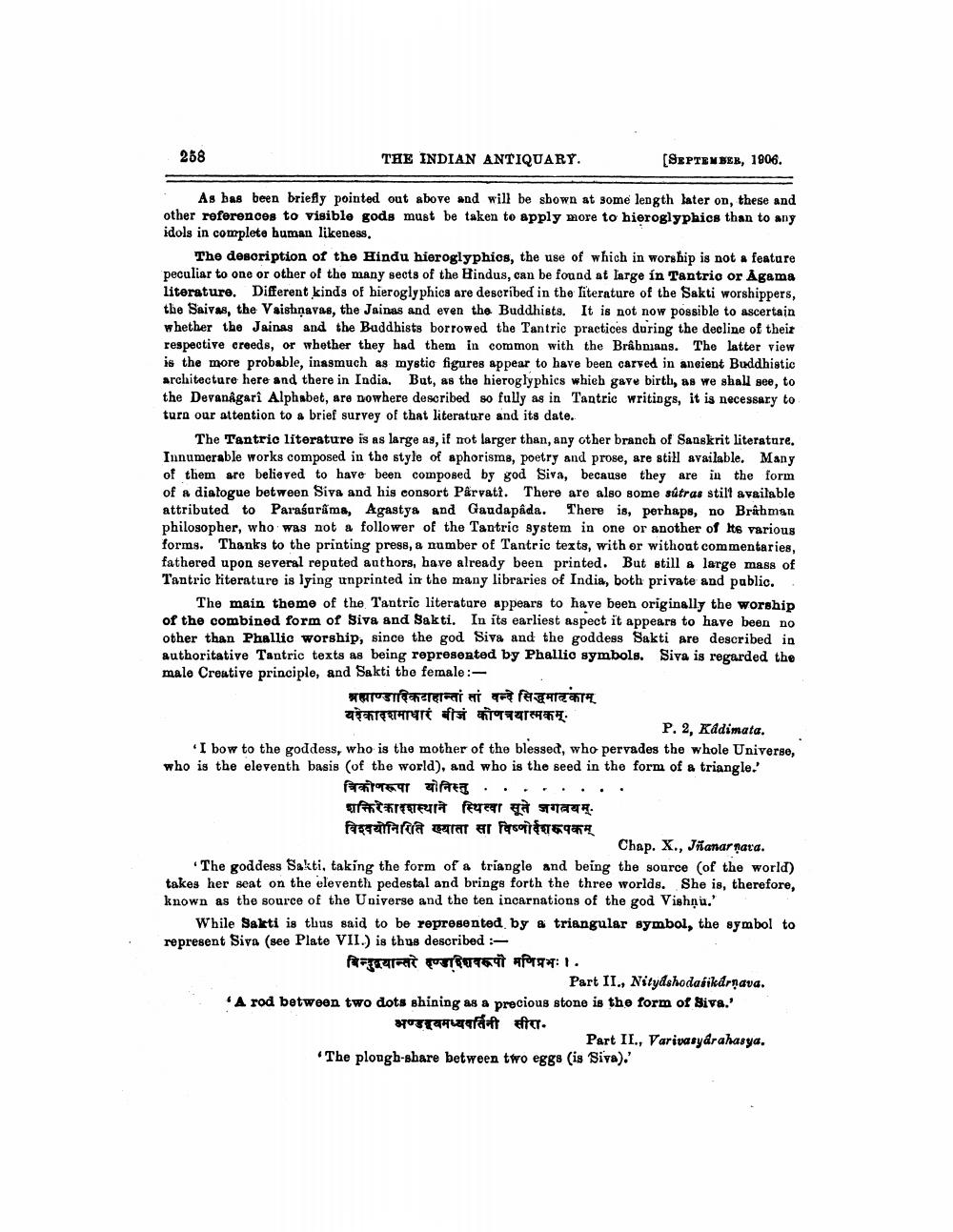________________
258
THE INDIAN ANTIQUARY.
(SEPTEMBER, 1906.
As bas been briefly pointed out above and will be shown at some length later on, these and other references to visible gods must be taken to apply more to hieroglyphics than to any idols in complete human likeness.
The description of the Hindu hieroglyphics, the use of which in worship is not a feature peculiar to one or other of the many sects of the Hindus, can be found at large in Tantric or Agama literature. Different kinds of bieroglyphics are described in the literature of the Sakti worshippers, the Saivas, the Vaishnavas, the Jainas and even the Buddhists. It is not now possible to ascertain whether the Jainas and the Buddhists borrowed the Tantric practices during the decline of their respective creeds, or whether they had them in common with the Brahmans. The latter view is the more probable, inasmuch as mystic figures appear to have been carved in ancient Buddhistic architecture here and there in India. But, as the hieroglyphics which gave birth, as we shall see, to the DevanÂgarî Alphabet, are nowhere described so fully as in Tantric writings, it is necessary to turn our attention to a brief survey of that literature and its date.
The Tantric literature is as large as, if not larger than any other branch of Sanskrit literature. Innumerable works composed in the style of aphorisms, poetry and prose, are still available. Many of them are believed to have been composed by god Siva, because they are in the form of a dialogue between Siva and his consort Pârvati. There are also some sútras still available attributed to Parasurama, Agastya and Gaudapâda. There is, perhaps, no Brahman philosopher, who was not a follower of the Tantric system in one or another of its various forms. Thanks to the printing press, a number of Tantric texts, with or without commentaries, fathered upon several reputed authors, have already been printed. But still a large mass of Tantric literature is lying unprinted in the many libraries of India, both private and public.
The main theme of the Tantric literature appears to have been originally the worship of the combined form of Siva and Sakti. In its earliest aspect it appears to have been no other than Phallic worship, since the god Siva and the goddess Sakti are described in authoritative Tantric texts as being represented by Phallio symbols. Siva is regarded the male Creative principle, and Sakti the female :
ब्रह्माण्डादिकटाहान्तां तां वन्दे सिद्धमारकाम् यरेकादशमाधारं बीजं कोणत्रयात्मकम्.
P. 2, Kddimata. I bow to the goddess, who is the mother of the blessed, who pervades the whole Universe, who is the eleventh basis of the world), and who is the seed in the form of a triangle.'
69T
. .... .... शक्तिरेकादशस्थाने स्थित्वा सूते जगवयम्. विश्वयोनिरिति ख्याता सा विष्णोर्दशरूपकम्
Chap. X., Jñanar nara. The goddess Sakti, taking the form of a triangle and being the source (of the world) takes her seat on the eleventh pedestal and brings forth the three worlds. She is, therefore, known as the source of the Universe and the ten incarnations of the god Vishnu.
While Sakti is thus said to be represented by a triangular symbol, the symbol to represent Siva (see Plate VII.) is thus described :fare quer 59 AP : 1.
Part II., Nitydshodasikdrņava. "A rod between two dots shining as a precious stone is the form of Siva.' भण्डबमध्यवर्तिनी सीरा.
Part II., Varivasyarahasya. "The plongb-share between two eggs (is Siva).'




